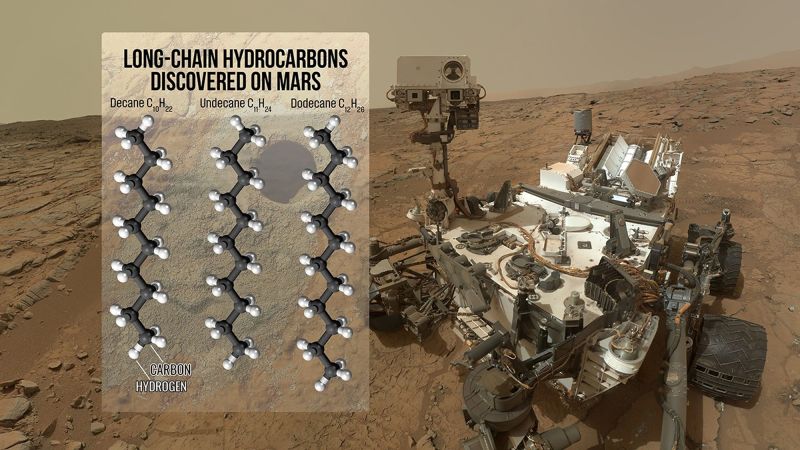NASA’s Curiosity rover has made a groundbreaking discovery on Mars, detecting the largest organic molecules ever found on the planet, which offers tantalizing hints about its ancient past. This breakthrough in Martian exploration suggests that complex organic chemistry, critical for life’s origin, may have occurred on Mars, as outlined in recent research published in the journal *Proceedings of the National Academy of Sciences*.
The organic compounds identified include decane, undecane, and dodecane, which emerged from the analysis of a 3.7 billion-year-old rock sample. This analysis was facilitated by the rover’s onboard laboratory known as SAM (Sample Analysis at Mars). The presence of these lengthy molecular chains is particularly intriguing for scientists as they could indicate fragments of fatty acids. These compounds serve as chemical building blocks for life, assisting in the formation of cell membranes. However, it is crucial to note that these organic molecules can form without life, particularly through chemical interactions when water meets minerals in hydrothermal vents.
While the detection of these compounds does not serve as direct evidence of past life on Mars, it does contribute valuable data to the list of organic substances discovered by robotic missions in recent years. The identification of fragile organic molecules also raises the hope of astrobiologists that any biosignatures from ancient life forms may still be detectable. Lead study author Dr. Caroline Freissinet, a research scientist at the French National Centre for Scientific Research, emphasized that the ability of Mars to preserve these delicate molecules could indicate the possibility of uncovering ancient life forms.
This finding fuels the ongoing conversation regarding the necessity for returning samples from Mars, allowing scientists to employ more sophisticated Earth-based tools to analyze them. The implications of such research could ultimately help determine if life ever existed beyond our planet.
Curiosity, having landed in Gale Crater on August 6, 2012, has traversed over 21 miles (34 kilometers) exploring the various geological features within the crater, including Mount Sharp. This location is pivotal, preserving millions of years of Martian geological history, depicting the planet’s transition from a wet to dry environment. One of the most significant samples collected during Curiosity’s mission was the Cumberland sample in May 2013, which was taken from a crater area reminiscent of an ancient lake bed.
This specific sample has undergone extensive analysis using SAM, revealing that Yellowknife Bay was once a wet environment where clay minerals formed. Such conditions would facilitate the concentration and preservation of organic molecules. Freissinet was part of a team that identified organic molecules within the Cumberland sample in 2015, finding indicators like sulfur and methane, which are essential for biological processes on Earth.
Scientists were surprised by the recent detection of long-chain hydrocarbons, prompting further experimentation to understand their origins—whether these compounds were remnants of fatty acids or formed through other means. Their studies revealed that these larger molecules were heavier and more complex than those previously identified on Mars, indicating their potential significance for understanding the origin of life.
Despite Curiosity’s current limitations in detecting life directly, the discoveries made thus far are pushing the mission’s objectives beyond initial expectations. Dr. Amy Williams, associate professor of geology at the University of Florida, notes that larger and more intricate molecules are essential for life’s potential emergence on Mars. The SAM instrument’s future capabilities raise hopes for identifying chemical signatures indicative of past life.
Though Curiosity will not revisit Yellowknife Bay, the pristine samples it has preserved offer opportunities for future experimentation. The ongoing collaboration among scientists is promising, as they strive to uncover the secrets that these Martian samples hold. Briony Horgan, involved with the Perseverance rover mission, acknowledged the importance of these findings for understanding ancient watery environments on Mars.
For the scientific community, the recent detection of fatty acids marks a significant milestone; while it does not provide definitive evidence of life, it reinforces the potential for organic molecules to provide clues to prebiotic processes and ancient biological signals. A growing body of evidence suggests that organic carbon on Mars may be more common than previously believed, indicating that life-supporting chemistry was possible in the planet’s ancient past.
As the European Space Agency gears up to launch its ExoMars Rosalind Franklin rover in 2028, scientists eagerly anticipate further investigations that could provide more substantial evidence of organic molecules deep beneath Mars’ surface. Concurrently, NASA’s Perseverance rover is actively collecting samples from Jezero Crater, with hopes of returning them to Earth in the 2030s.
Ultimately, the discoveries made by Curiosity and Perseverance should inspire optimism that the ongoing quest to uncover the history of life on Mars may soon yield profound insights, particularly as researchers contemplate what was happening on our own planet during the same epoch. With many questions still unanswered, the drive to explore Mars for signs of ancient microbial life continues to captivate and challenge scientists worldwide.












